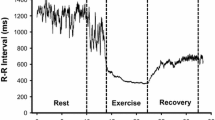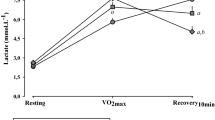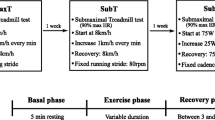Abstract
Heart rate variability (HRV) was assessed during the short- (within 1 h) and long- (within 48 h) term recovery following a single bout of either constant (CST) or interval training (SWEET) exercise performed at the same total physical work [9.4 (0.3) kJ kg−1]. R-R intervals, systolic (SAP) and diastolic (DAP) arterial pressures were recorded in supine and upright positions before and 1, 24 and 48 h after the termination of the exercises in ten male subjects [mean (SEM), age 24.6 (0.6) years, height 177.2 (1.1) cm and body mass 68.5 (0.9) kg]. The parameters were also recorded in the supine position during the first 20 min following the end of the exercise. Spectral analysis parameters of HRV [total (TP), low- (LF), and high- (HF) frequency power, and LF/TP, HF/TP and LF/HF ratios] were determined over 5 min during each phase. Except for higher HF values in both supine and upright positions during the first hour following CST compared with SWEET, cardiovascular and HRV analysis responses were of the same magnitude after their termination. R-R intervals, TP, and HF/TP were significantly decreased while LF/TP and LF/HF were significantly increased during the early recovery, when compared with control values. This could be a response to the significant decrease in SAP and DAP at this time. Twenty-four and 48 h after the end of the exercise, HRV parameters were at the same levels as before exercises in the supine posture, but a persistent tachycardia continued to be observed in the upright posture, together with reduced TP values, showing that cardiovascular functions were still disturbed. The short-term HRV recovery seemed dependent on the type of exercise, contrary to the long-term recovery.

Similar content being viewed by others
References
Akselrod S, Gordon D, Ubel FA, Shannon DC, Berger AC, Cohen RJ (1981) Power spectrum analysis of heart rate fluctuation: a quantitative probe of beat-to-beat cardiovascular control. Science 213:220–222
Albert CM, Mittleman MA, Chae CU, Lee IM, Hennekens CH, Manson JE (2000) Triggering of sudden death from cardiac causes by vigorous exertion. N Engl J Med 343:1355–1361
Arai Y, Saul JP, Albrecht P, Hartley LH, Lilly LS, Cohen RJ, Colucci WS (1989) Modulation of cardiac autonomic activity during and immediately after exercise. Am J Physiol 256:H132–H141
Bernardi L, Leuzzi S, Radaelli A, Passino C, Johnston JA, Sleight P (1994) Low-frequency spontaneous fluctuations of R-R interval and blood pressure in conscious humans: a baroreceptor or central phenomenon? Clin Sci (Lond) 87:649–654
Bernardi L, Passino C, Robergs R, Appenzeller O (1997) Acute and persistent effects of a 46-kilometer wilderness trail run at altitude: cardiovascular autonomic modulation and baroreflexes. Cardiovasc Res 34:273–280
Billat LV (2001) Interval training for performance: a scientific and empirical practice. Special recommendations for middle- and long-distance running. Part I: aerobic interval training. Sports Med 31:13–31
Brown TE, Beightol LA, Koh J, Eckberg DL (1993) Important influence of respiration on human R-R interval power spectra is largely ignored. J Appl Physiol 75:2310–2317
Brownley KA, Hinderliter AL, West SG, Girdler SS, Sherwood A, Light KC (2003) Sympathoadrenergic mechanisms in reduced hemodynamic stress responses after exercise. Med Sci Sports Exerc 35:978–986
Cooke WH, Cox JF, Diedrich AM, Taylor A, Beightol LA, Ames IV JE, Hoag JB, Seidel H, Eckberg DL (1998) Controlled breathing protocols probe human autonomic cardiovascular rythms. Am J Physiol 274:H709–H718
Curtis BM, O’Keefe JH Jr (2002) Autonomic tone as a cardiovascular risk factor: the dangers of chronic fight or flight. Mayo Clin Proc 77:45–54
Fox EL, Bartels RL, Billings CE, O’Brien R, Bason R, Mathews DK (1975) Frequency and duration of interval training programs and changes in aerobic power. J Appl Physiol 38:481–484
Furlan R, Piazza S, Dell’Orto S, Gentile E, Cerutti S, Pagani M, Malliani A (1993) Early and late effects of exercise and athletic training on neural mechanisms controlling heart rate. Cardiovasc Res 27:482–488
Furlan R, Pagani M, Malliani A (1994) Effects of exercise on the autonomic control of the heart: training or overtraining? Cardiovasc Res 28:142–143
Geny B, Saini J, Mettauer B, Lampert E, Piquard F, Follenius M, Epailly E, Schnedecker B, Eisenmann B, Haberey P, Lonsdorfer J (1996) Effect of short-term endurance training on exercise capacity, haemodynamics and atrial natriuretic peptide secretion in heart transplant recipients. Eur J Appl Physiol 73:259–266
Gimenez M, Servera E, Salinas W (1982) Square-wave endurance exercise test (SWEET) for training and assessment in trained and untrained subjects. I. Description and cardiorespiratory responses. Eur J Appl Physiol 49:359–368
Goldberger JJ (1999) Sympathovagal balance: how should we measure it? Am J Physiol 276:H1273–H1280
Halliwill JR, Taylor JA, Hartwig TD, Eckberg DL (1996) Augmented baroreflex heart rate gain after moderate-intensity, dynamic exercise. Am J Physiol 270:R420–R426
Hautala A, Tulppo MP, Makikallio TH, Laukkanen R, Nissila S, Huikuri HV (2001) Changes in cardiac autonomic regulation after prolonged maximal exercise. Clin Physiol 21:238–245
Hayashi N, Nakamura Y, Muraoka I (1992) Cardiac autonomic regulation after moderate and exhaustive exercises. Ann Physiol Anthropol 11:333–338
Iellamo F, Legramante JM, Massaro M, Raimondi G, Galante A (2000) Effects of a residential exercise training on baroreflex sensitivity and heart rate variability in patients with coronary artery disease: A randomized, controlled study. Circulation 102:2588–2592
James DV, Barnes AJ, Lopes P, Wood DM (2002) Heart rate variability: response following a single bout of interval training. Int J Sports Med 23:247–251
Kenney MJ, Seals DR (1993) Postexercise hypotension. Key features, mechanisms, and clinical significance. Hypertension 22:653–664
Maron BJ (2000) The paradox of exercise. N Engl J Med 343:1409–1411
Maslowsky F, Anza C, Pedretti R, Santoro F, Bonelli R, Pribevich M, Caru B (1994) Effects of two types of physical training (aerobic versus anaerobic) in early cardiac trasnplantation (abstract). Eur Heart J 15:320
Melanson EL, Freedson PS (2001) The effect of endurance training on resting heart rate variability in sedentary adult males. Eur J Appl Physiol 85:442–449
Mourot L, Bouhaddi M, Perrey S, Rouillon JD, Regnard J (2004) Quantitative Poincare plot analysis of heart rate variability: effect of endurance training. Eur J Appl Physiol 91:79–87
Nakamura Y, Yamamoto Y, Muraoka I (1993) Autonomic control of heart rate during physical exercise and fractal dimension of heart rate variability. J Appl Physiol 74:875–881
Pagani M, Malliani A (2000) Interpreting oscillations of muscle sympathetic nerve activity and heart rate variability. J Hypertens 18:1709–1719
Pagani M, Lombardi F, Guzzetti S, Rimoldi O, Furlan R, Pizzinelli P, Sandrone G, Malfatto G, Dell’Orto S, Piccaluga E (1986) Power spectral analysis of heart rate and arterial pressure variabilities as a marker of sympatho-vagal interaction in man and conscious dog. Circ Res 59:178–193
Perini R, Orizio C, Comande A, Castellano M, Beschi M, Veicsteinas A (1989) Plasma norepinephrine and heart rate dynamics during recovery from submaximal exercise in man. Eur J Appl Physiol 58:879–883
Perini R, Orizio C, Baselli G, Cerutti S, Veicsteinas A (1990) The influence of exercise intensity on the power spectrum of heart rate variability. Eur J Appl Physiol 61:143–148
Piepoli M, Coats AJ (1994) Effects of exercise on the autonomic control of the heart: training or overtraining? Cardiovasc Res 28:141–142
Piepoli M, Coats AJ, Adamopoulos S, Bernardi L, Feng YH, Conway J, Sleight P (1993) Persistent peripheral vasodilation and sympathetic activity in hypotension after maximal exercise. J Appl Physiol 75:1807–1814
Pomeranz B, Macaulay RJ, Caudill MA, Kutz I, Adam D, Gordon D, Kilborn KM, Barger AC, Shannon DC, Cohen RJ (1985) Assessment of autonomic function in humans by heart rate spectral analysis. Am J Physiol 248:H151–H153
Raine NM, Cable NT, George KP, Campbell IG (2001) The influence of recovery posture on post-exercise hypotension in normotensive men. Med Sci Sports Exerc 33:404–412
Task Force of the European Society of Cardiology and the North American Society of Pacing and Electrophysiology (1996). Heart rate variability: standards of measurement, physiological interpretation and clinical use. Circulation 93:1043–1065
Terziotti P, Schena F, Gulli G, Cevese A (2001) Post-exercise recovery of autonomic cardiovascular control: a study by spectrum and cross-spectrum analysis in humans. Eur J Appl Physiol 84:187–194
Tordi N, Belli A, Mougin F, Rouillon JD, Gimenez M (2001a) Specific and transfer effects induced by arm or leg training. Int J Sports Med 22:517–524
Tordi N, Dugue B, Klupzinski D, Rasseneur L, Rouillon JD, Lonsdorfer J (2001b) Interval training program on a wheelchair ergometer for paraplegic subjects. Spinal Cord 39:532–537
Wasserman K (1986) The anaerobic threshold: definition, physiological significance and identification. Adv Cardiol 35:1–23
Yamamoto Y, Hughson RL (1991) Coarse-graining spectral analysis: new method for studying heart rate variability. J Appl Physiol 71:1143–1150
Yamamoto Y, Hughson RL (1994) On the fractal nature of heart rate variability in humans: effects of data length and beta-adrenergic blockade. Am J Physiol 266:R40–R49
Yamamoto Y, Hughson RL, Peterson JC (1991) Autonomic control of heart rate during exercise studied by heart rate variability spectral analysis. J Appl Physiol 71:1136–1142
Yamamoto Y, Nakamura Y, Sato H, Yamamoto M, Kato K, Hughson RL (1995) On the fractal nature of heart rate variability in humans: effects of vagal blockade. Am J Physiol 269:R830–R837
Acknowledgements
We especially thank the subjects who volunteered for this study. This work was funded by the granting of the EA 479 by the Minsitère de l’Education Nationale, de la Recherche et de la Technologie, France.
Author information
Authors and Affiliations
Corresponding author
Rights and permissions
About this article
Cite this article
Mourot, L., Bouhaddi, M., Tordi, N. et al. Short- and long-term effects of a single bout of exercise on heart rate variability: comparison between constant and interval training exercises. Eur J Appl Physiol 92, 508–517 (2004). https://doi.org/10.1007/s00421-004-1119-0
Accepted:
Published:
Issue Date:
DOI: https://doi.org/10.1007/s00421-004-1119-0




